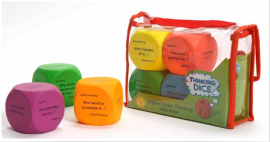 In our Teaching and Learning INSET sessions at Beaumont, we always try to demonstrate the ideas we are aiming to raise and discuss, by using them in the session itself. For our third T&L INSET of this year we focused on how to use questioning in lessons in order to assess understanding, increase engagement and promote depth in pupil learning. We tried out and discussed a variety of techniques during the session and staff (as ever) were enthusiastic about about sharing their own ideas.
In our Teaching and Learning INSET sessions at Beaumont, we always try to demonstrate the ideas we are aiming to raise and discuss, by using them in the session itself. For our third T&L INSET of this year we focused on how to use questioning in lessons in order to assess understanding, increase engagement and promote depth in pupil learning. We tried out and discussed a variety of techniques during the session and staff (as ever) were enthusiastic about about sharing their own ideas.
The first slide on this powerpoint shows the questions we talked about first – showing questions at the start of the lesson as pupils arrive is always a good way to get them thinking right from their arrival in the room, the trick being to find the “right” questions. We then went on to play “pass the parcel” (yes, we had a real parcel and music – thanks Dave) and inside each layer was a new question which we could discuss. This idea could be used in small groups to promote discussion amongst peers, or as a whole class for assessing understanding and promoting further learning. As a whole class teaching and assessing device, it works at it’s best when the questions are “bounced” around – using the ideas from one pupil to feed the understanding and further ideas from others. The technique of “pose, pause, pounce, bounce” promoted by @TeacherToolkit is a useful tool here. The questions we discussed in our pass the parcel were:
- What do you do about the student who always says “I don’t know”?
- How can you ensure the class listen to and build upon the responses of others?
- How do you encourage students to ask quality questions before, during and after your lessons?
- How do you ensure your questions cater for all abilities whilst making sure all students are engaged?
- What is the best question you have ever been asked by a student?
 We then had a go at using the “Thinking Dice” by throwing these lovely soft cubes of questions around the room and thinking up questions as we went along. Something similar with particular questions could be produced by pupils (cube nets are very easy to generate) or by using the dice which have a little whiteboard on each face (see the advent calendar).
We then had a go at using the “Thinking Dice” by throwing these lovely soft cubes of questions around the room and thinking up questions as we went along. Something similar with particular questions could be produced by pupils (cube nets are very easy to generate) or by using the dice which have a little whiteboard on each face (see the advent calendar).
A treasure hunt followed where we had time to think about how some very useful questions can be used with a very powerful effect – allowing pupils to make connections, extend their thinking, provide more depth in their answers, but also teach the idea that learning is also about them asking quality questions of their teacher (Skills for Success strikes again!).
Staff then spent some time thinking about a lesson they were going to teach the next day, using the questioning triangle and answers triangle to plan their questions for the lesson. They considered:
- When they were going to ask the question (at which point in the lesson);
- How they were going to ask the question (a technique we had talked about or another they already knew to be successful);
- How the answers might affect the rest of the lesson (there is space to write these thoughts at the bottom of the sheet).
Most felt that this process was extremely valuable as it showed how by deciding upon the questions for a lesson, and considering what a teacher does with the results, allows the lesson to be very effectively planned.
It was then time for a bit of origami, as those teachers who could remember fortune tellers from their primary school days deftly demonstrated the technique of folding which had previously allowed them to find out which primary school classmate was to be their future husband (or wife!). These fortune tellers are a lovely engaging way to get pupils asking and discussing questions, perhaps even designing their own in order to challenge their peers.
Finally, the Questioning Quails were brought out so that staff could write down ideas which they already use and know to be successful ready for sharing around the school. Some ideas are already in the nest of Questioning Quails in the staff room, some will be made into cards for the ever growing black box of ideas, and we will put a list of as many as we can in a blog post once they have all been gathered in.

You must be logged in to post a comment.